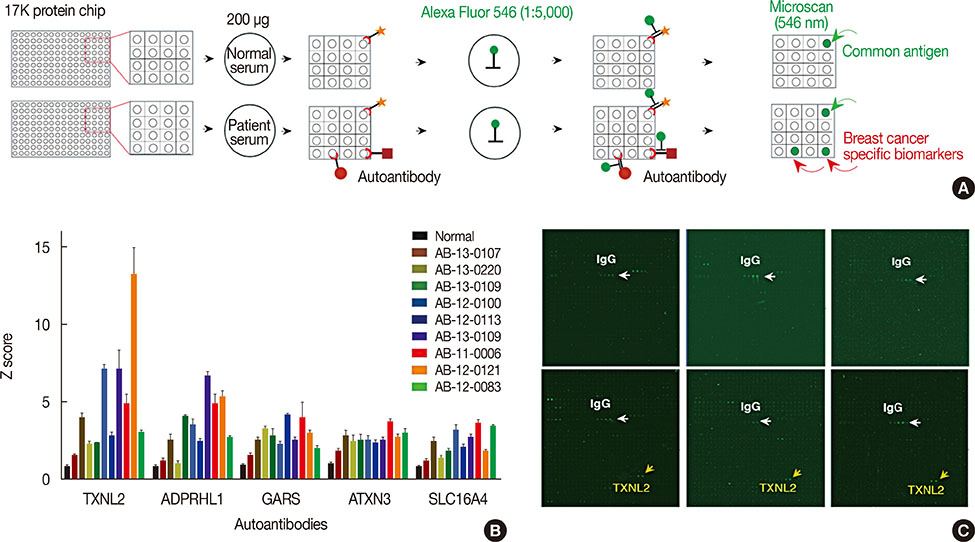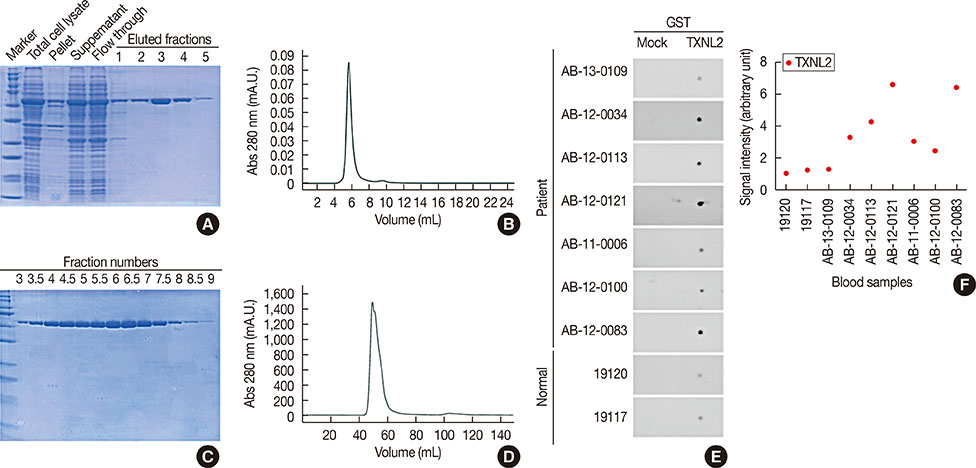J Breast Cancer.
2018 Mar;21(1):87-90. 10.4048/jbc.2018.21.1.87.
Identification of the Thioredoxin-Like 2 Autoantibody as a Specific Biomarker for Triple-Negative Breast Cancer
- Affiliations
-
- 1Genomic Instability Research Center, Ajou University School of Medicine, Suwon, Korea. hckang@ajou.ac.kr
- 2Department of Physiology, Ajou University School of Medicine, Suwon, Korea.
- 3Department of Biomedical Sciences, Ajou University School of Medicine, Suwon, Korea.
- 4Department of Surgery, Ajou University School of Medicine, Suwon, Korea.
- 5Department of Bio-Engineering, Life Science RD Center, Sinil Pharmaceutical Co., Seongnam, Korea.
- KMID: 2441872
- DOI: http://doi.org/10.4048/jbc.2018.21.1.87
Abstract
- Triple-negative breast cancer (TNBC) has a higher risk of death within 5 years of being diagnosed than the other forms of breast cancer. It is the second leading cause of death due to cancer among women. Currently, however, no diagnostic blood-based biomarker exists to identify the early stages of TNBC. To address this point, we utilized a human protein microarray system to identify serum autoantibodies that showed different expression patterns between TNBC and normal serum samples, and identified five autoantibodies showing TNBC-specific expression. Among them, we selected the thioredoxin-like 2 (TXNL2) autoantibody and evaluated its diagnostic relevance by dot blot analysis with the recombinant TXNL2 protein. We demonstrated that the TXNL2 autoantibody showed 2- to 6-fold higher expression in TNBC samples than in normal samples suggesting that serum TXNL2 autoantibodies are potential biomarkers for TNBC.
MeSH Terms
Figure
Reference
-
1. Perou CM, Sørlie T, Eisen MB, van de Rijn M, Jeffrey SS, Rees CA, et al. Molecular portraits of human breast tumours. Nature. 2000; 406:747–752.
Article2. Kalimutho M, Parsons K, Mittal D, López JA, Srihari S, Khanna KK. Targeted therapies for triple-negative breast cancer: combating a stubborn disease. Trends Pharmacol Sci. 2015; 36:822–846.
Article3. Collignon J, Lousberg L, Schroeder H, Jerusalem G. Triple-negative breast cancer: treatment challenges and solutions. Breast Cancer (Dove Med Press). 2016; 8:93–107.4. Fleisher B, Clarke C, Ait-Oudhia S. Current advances in biomarkers for targeted therapy in triple-negative breast cancer. Breast Cancer (Dove Med Press). 2016; 8:183–197.
Article5. Wahba HA, El-Hadaad HA. Current approaches in treatment of triplenegative breast cancer. Cancer Biol Med. 2015; 12:106–116.6. Ramachandran N, Srivastava S, Labaer J. Applications of protein microarrays for biomarker discovery. Proteomics Clin Appl. 2008; 2:1444–1459.
Article7. Conrad K, Roggenbuck D, Reinhold D, Sack U. Autoantibody diagnostics in clinical practice. Autoimmun Rev. 2012; 11:207–211.
Article8. Xu YW, Peng YH, Chen B, Wu ZY, Wu JY, Shen JH, et al. Autoantibodies as potential biomarkers for the early detection of esophageal squamous cell carcinoma. Am J Gastroenterol. 2014; 109:36–45.
Article9. Zaenker P, Ziman MR. Serologic autoantibodies as diagnostic cancer biomarkers: a review. Cancer Epidemiol Biomarkers Prev. 2013; 22:2161–2181.
Article10. Macdonald IK, Parsy-Kowalska CB, Chapman CJ. Autoantibodies: opportunities for early cancer detection. Trends Cancer. 2017; 3:198–213.
Article11. Pieper R, Gatlin CL, Makusky AJ, Russo PS, Schatz CR, Miller SS, et al. The human serum proteome: display of nearly 3700 chromatographically separated protein spots on two-dimensional electrophoresis gels and identification of 325 distinct proteins. Proteomics. 2003; 3:1345–1364.
Article12. Qu Y, Wang J, Ray PS, Guo H, Huang J, Shin-Sim M, et al. Thioredoxin-like 2 regulates human cancer cell growth and metastasis via redox homeostasis and NF-kappaB signaling. J Clin Invest. 2011; 121:212–225.
Article13. Zhu H, Cox E, Qian J. Functional protein microarray as molecular decathlete: a versatile player in clinical proteomics. Proteomics Clin Appl. 2012; 6:548–562.
Article14. Cha H, Kim JM, Oh JG, Jeong MH, Park CS, Park J, et al. PICOT is a critical regulator of cardiac hypertrophy and cardiomyocyte contractility. J Mol Cell Cardiol. 2008; 45:796–803.
Article
- Full Text Links
- Actions
-
Cited
- CITED
-
- Close
- Share
- Similar articles
-
- Clinicopathologic Characteristics and Prognosis of Early Stage Triple Negative Breast Cancer: Comparison with Non-triple Negative Group
- Fear of Cancer Recurrence and Unmet Needs in Triple Negative Breast Cancer Survivors
- Molecular Classification of Triple-Negative Breast Cancer
- Comment on “Histomorphological Factors Predicting the Response to Neoadjuvant Chemotherapy in Triple-Negative Breast Cancerâ€
- Bilateral Triple-Negative Invasive Breast Cancer with a BRCA2 Mutation, and Glioblastoma: A Case Report and Literature Review



